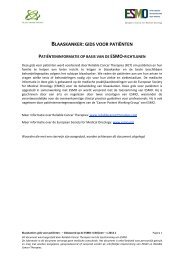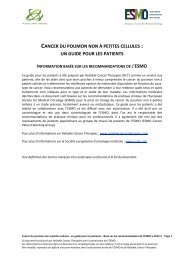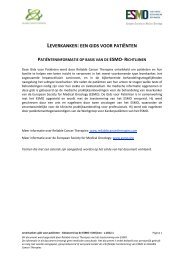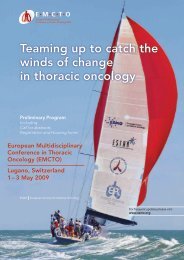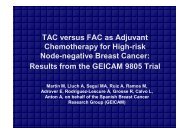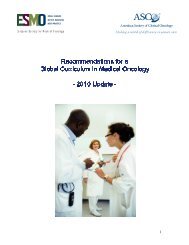Bladder cancer - European Society for Medical Oncology
Bladder cancer - European Society for Medical Oncology
Bladder cancer - European Society for Medical Oncology
You also want an ePaper? Increase the reach of your titles
YUMPU automatically turns print PDFs into web optimized ePapers that Google loves.
WHAT HAPPENS AFTER THE TREATMENT?<br />
It is not unusual <strong>for</strong> <strong>cancer</strong> patients to experience treatment‐related<br />
symptoms after the treatment has been completed.<br />
• Patients may experience anxiety, sleeping difficulty or depression, and<br />
may need psychological support.<br />
• During and after treatment, nutrition may become problematic due to<br />
reduced appetite, nausea and general malaise<br />
• Difficulties in concentration and memorization are not uncommon<br />
side effects* of systemic chemotherapy, i.e. when administered in a vein or orally.<br />
Follow‐up* with doctors<br />
After completion of treatment the doctor will propose a follow‐up aiming to:<br />
• Detect and prevent adverse effects of the treatment<br />
• Detect possible recurrence* as soon as possible and direct appropriate treatment<br />
• Provide medical in<strong>for</strong>mation, psychological support and referral to specialized support<br />
providers to optimize returning to normal daily life.<br />
The follow‐up protocol will include regularly timed office visits and investigations. The protocol<br />
depends on the grade* and staging* of the bladder tumor that was treated, and on the type of<br />
treatment given. In general, follow‐up visits may include a combination of the following<br />
investigations:<br />
• History of general physical health and bladder <strong>cancer</strong>‐related symptoms since the last visit<br />
• Cystoscopy* to detect recurrence* and to per<strong>for</strong>m a biopsy* of new lesions<br />
• Imaging of the upper urinary system<br />
• Urinary cytology*: laboratory examination of the urine <strong>for</strong> the presence of tumor cells that<br />
are shed by a potentially recurring bladder tumor.<br />
• Laboratory investigations: blood chemistry and kidney function<br />
• Repeated radiologic investigations* in case initial examinations showed abnormal findings.<br />
There are no generally accepted follow‐up protocols. The following are recommended possible<br />
regimens:<br />
When organ preservation therapy* is given, very close follow‐up is mandatory: cystoscopy, urine<br />
cytology* and/or bladder biopsy* are recommended with a frequency of 3 months <strong>for</strong> the first 2<br />
years, and every 6 months thereafter. This is also the case in patients who have been treated with<br />
radiotherapy*. After cystectomy, clinical control* should take place every 3 months during the first 2<br />
years and subsequently every 6 months <strong>for</strong> 5 years.<br />
Returning to normal life<br />
Returning to normal daily life may be difficult knowing that the <strong>cancer</strong> may come back. If any of the<br />
known risk factors* <strong>for</strong> bladder <strong>cancer</strong> are present, it is advised to maximally eliminate these.<br />
Follow‐up* visits with the doctor provide an opportunity <strong>for</strong> the patient to obtain medical<br />
in<strong>for</strong>mation, psychological support and referral to specialized support providers. Additional expert<br />
<strong>Bladder</strong> <strong>cancer</strong>: a guide <strong>for</strong> patients‐ In<strong>for</strong>mation based on ESMO Clinical Practice Guidelines ‐v.2012.1 Page 19<br />
This document is provided by Reliable Cancer Therapies with the permission of ESMO.<br />
The in<strong>for</strong>mation in this document does not replace a medical consultation. It is <strong>for</strong> personal use only and cannot be modified,<br />
reproduced or disseminated in any way without written permission from ESMO and Reliable Cancer Therapies.





